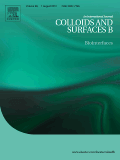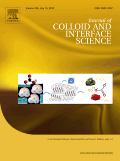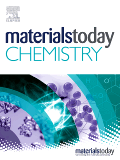
COLLOIDS AND SURFACES A-PHYSICOCHEMICAL AND ENGINEERING ASPECTS
Scope & Guideline
Elevating Understanding in Surface and Colloid Chemistry
Introduction
Aims and Scopes
- Colloidal Systems and Interfaces:
Exploration of the properties and behaviors of colloids, including stabilizing mechanisms, interactions, and dynamics at the nanoscale. - Surface Chemistry:
Investigation of surface modification techniques and their impact on material properties, including adhesion, wettability, and reactivity. - Nanomaterials and Functional Materials:
Development and characterization of novel nanomaterials for applications in catalysis, energy storage, environmental remediation, and drug delivery. - Photocatalysis and Environmental Applications:
Research on photocatalytic processes for pollutant degradation, CO2 reduction, and water treatment, focusing on the design and efficiency of photocatalytic systems. - Biomedical Applications:
Application of colloidal and surface science principles in drug delivery systems, bioimaging, and tissue engineering. - Rheology and Fluid Dynamics:
Study of the flow behavior of colloidal dispersions and the impact of rheological properties on processing and application.
Trending and Emerging
- Sustainable Materials and Green Chemistry:
There is an increasing focus on eco-friendly synthesis methods, sustainable materials, and green chemistry practices, particularly in the context of waste valorization and biopolymer applications. - Smart and Responsive Materials:
Research on materials that exhibit smart responses to environmental changes (e.g., pH, temperature, light) is gaining traction, highlighting their potential in drug delivery and adaptive technologies. - Advanced Photocatalytic Systems:
The development of efficient photocatalytic systems for environmental applications, particularly for the degradation of pollutants and CO2 reduction, is a notable trend. - Bio-inspired and Biomimetic Approaches:
Emerging studies are increasingly drawing inspiration from nature to develop novel materials and applications, such as self-healing coatings and superhydrophobic surfaces. - Nanostructured Functional Surfaces:
Research is trending towards the fabrication and application of nanostructured surfaces that enhance properties such as antifogging, anti-corrosion, and antimicrobial activity.
Declining or Waning
- Traditional Chemical Engineering Methods:
There has been a noticeable decrease in publications centered on conventional chemical engineering methods in favor of more innovative and interdisciplinary approaches, particularly those that integrate nanotechnology and materials science. - Basic Theoretical Studies:
Papers focusing solely on theoretical models without practical applications have become less frequent, as there is a stronger emphasis on experimental validation and real-world applications. - Surface Treatments for Conventional Materials:
Interest in surface treatments specifically for traditional materials (like metals and plastics) appears to be waning, with a shift towards advanced materials such as nanocomposites and bioinspired surfaces.
Similar Journals

Surface Innovations
Transforming Ideas into Surface SolutionsSurface Innovations, an esteemed journal published by Emerald Group Publishing Ltd, serves as a crucial platform for researchers and professionals working within the fields of Materials Chemistry, Process Chemistry and Technology, and Surfaces, Coatings and Films. Launched in 2013, this journal has garnered attention for its commitment to advancing knowledge and innovation, holding a distinguished Q3 ranking in multiple categories as of 2023. With a focus on the latest methodologies and applications in surface science, Surface Innovations not only facilitates the dissemination of cutting-edge research but also encourages interdisciplinary collaboration among scientists and engineers. While not an open-access journal, it offers numerous options for accessibility to engage a wide array of audiences, making it a valuable resource for those looking to expand their understanding and expertise in this rapidly evolving field. The journal's consistent inclusion in high-ranking Scopus categories further underscores its academic impact and relevance.

Applied Surface Science Advances
Leading the Charge in Applied Surface InnovationsApplied Surface Science Advances, published by ELSEVIER, is a leading open-access journal since 2020, based in the Netherlands. With ISSN 2666-5239, this journal conducts pioneering research in the rapidly developing domains of Surfaces and Interfaces and Surfaces, Coatings, and Films. Holding a prestigious Q1 category ranking in both fields for 2023, it underscores its significance, ranking #12 out of 57 in Surfaces and Interfaces and #28 out of 132 in Materials Science according to Scopus metrics, placing it in the 79th percentile. This journal's accessible format ensures that groundbreaking studies and innovations are available to a broad audience, fostering collaboration and advancement within the scientific community. Committed to excellence, Applied Surface Science Advances not only encourages the dissemination of high-quality research but also aims to be a key resource for researchers, professionals, and students interested in the latest developments and applications in surface science.

COLLOIDS AND SURFACES B-BIOINTERFACES
Unraveling Complexities of Colloids and SurfacesCOLLOIDS AND SURFACES B-BIOINTERFACES is a premier interdisciplinary journal published by Elsevier, dedicated to advancing the knowledge of interfaces and interactions in biological systems and their applications in biotechnology. With an impressive impact factor that underscores its significance in the field, the journal ranks in the Q1 category for Biotechnology, Medicine, and Physical and Theoretical Chemistry in the 2023 classifications. It has achieved notable positions in Scopus rankings, highlighted by a top-tier rank in Colloid and Surface Chemistry, demonstrating its influence on ongoing research. Spanning from 1993 to 2025, C&B B-BIOINTERFACES serves as a vital platform for innovative research contributions, fostering knowledge exchange among researchers, professionals, and students. The journal focuses on the intricate relationships between colloids, surfaces, and biological materials, paving the way for groundbreaking developments in drug delivery, biomaterials, and nanotechnology. While not an open-access publication, readers can anticipate insightful, high-quality articles that significantly impact the scientific community.

JOURNAL OF COLLOID AND INTERFACE SCIENCE
Transforming Insights into Colloidal and Surface InteractionsJOURNAL OF COLLOID AND INTERFACE SCIENCE, published by Academic Press Inc, Elsevier Science, is a premier peer-reviewed journal that has been a cornerstone in the fields of colloid, surface chemistry, and biomaterials since its inception in 1966. With a strong impact in its respective disciplines, the journal holds a prestigious status in quartile rankings, including Q1 in Biomaterials, Colloid and Surface Chemistry, Electronic, Optical and Magnetic Materials, as well as Surfaces, Coatings, and Films for 2023. Its outstanding Scopus rankings, such as #4 in Colloid and Surface Chemistry and #6 in Surfaces, Coatings and Films, highlight its vital role in advancing research and understanding in these cutting-edge areas. Although not an open-access journal, it provides valuable insights and advancements that cater to an audience of researchers, professionals, and students aiming to push the boundaries of material science. As it continues to publish high-quality research through 2025 and beyond, the journal remains an essential resource for those involved in the exploration of the interactions between particles and surfaces.

JOURNAL OF POROUS MATERIALS
Advancing Knowledge in Porous Materials ScienceJOURNAL OF POROUS MATERIALS, published by SPRINGER, is an esteemed peer-reviewed journal in the field of materials science and engineering, with a particular focus on porous materials, their properties, and applications. Since its inception in 1995, this journal has become a pivotal platform for innovative research, offering a robust repository of knowledge with a timeline extending through to 2024. The journal is recognized for its influential contributions, as evidenced by its Q2 quartile ranking in both Materials Science and Mechanical Engineering categories, and its strong performance in Scopus rankings, placing it in the 71st percentile for Mechanical Engineering. Researchers and professionals in the field will find essential insights into the latest advancements and interdisciplinary approaches related to porous materials. While the journal operates under a subscription model, its reach and significance in advancing the understanding of porous materials make it a vital resource for academics and industry practitioners seeking to apply cutting-edge research to real-world challenges.

Materials Today Chemistry
Catalyzing Discoveries in Advanced MaterialsMaterials Today Chemistry, published by Elsevier Science Ltd, is a leading journal in the field of materials science, with a primary focus on innovative research and advancements in chemistry relating to materials. Operating under ISSN 2468-5194, the journal has made a significant impact in various specialized areas such as biomaterials, catalysis, colloid and surface chemistry, and polymers, achieving a Q1 ranking across these categories in 2023. With its commitment to high-quality, peer-reviewed content, Materials Today Chemistry serves as an essential platform for researchers, professionals, and students aiming to stay at the forefront of materials research. The journal provides an open access model, enabling wide dissemination of research findings and fostering collaboration among the scientific community. Its esteemed ranking on Scopus, including a remarkable percentile position in materials chemistry and catalysis, underscores its importance in advancing the understanding and application of novel materials. Whether you're delving into cutting-edge synthesis techniques or exploring the latest in materials applications, Materials Today Chemistry remains a pivotal resource for breakthrough discoveries and pivotal insights in the realm of materials science.

SURFACE AND INTERFACE ANALYSIS
Bridging Disciplines through Surface ScienceSURFACE AND INTERFACE ANALYSIS, published by WILEY in the United Kingdom, is a renowned journal specializing in the examination of nanoscale phenomena and the properties of surfaces and interfaces across various materials. With a focus on advancing the fields of Chemistry, Condensed Matter Physics, and Materials Science, this journal has established itself as a critical resource since its inception in 1979, bridging over four decades of scientific discourse. Notably, it holds a commendable position in the Scopus rankings, emerging in the 2023 Q3 quartile across multiple categories, including Chemistry (miscellaneous) and Surfaces, Coatings, and Films. Although it does not currently offer Open Access, SURFACE AND INTERFACE ANALYSIS remains pivotal in disseminating high-quality research, providing an essential platform for academic scholars, industry professionals, and students aiming to deepen their understanding of surface phenomena and material characteristics. Its comprehensive coverage of innovative methodologies, experimental results, and theoretical insights reaffirm its significance in the scientific community.

CURRENT OPINION IN COLLOID & INTERFACE SCIENCE
Advancing the Frontiers of Colloid and Interface ScienceCURRENT OPINION IN COLLOID & INTERFACE SCIENCE, published by Elsevier Science London, serves as a premier platform for researchers and professionals in the field of colloid, interface science, and related disciplines. With an impressive Q1 ranking in multiple categories including Colloid and Surface Chemistry, Physical and Theoretical Chemistry, Polymers and Plastics, as well as Surfaces and Interfaces, this journal showcases cutting-edge developments and expert opinions that drive innovation in these areas. As a leader in its field, it maintains robust academic standards, reflected in its high percentile rankings across various Scopus categories, such as 3rd in Surfaces and Interfaces and 10th in Physical and Theoretical Chemistry. While the journal is not Open Access, it provides valuable insights to a wide audience, making it an essential resource for advancing knowledge and fostering collaborations among researchers, academics, and industry professionals alike. With a continual publication timeline extending from 1996 to 2024, it captures the evolving landscape of colloid and interface science, ensuring that readers are equipped with the latest findings and perspectives.

Frontiers of Materials Science
Unveiling Cutting-Edge Research in Materials ScienceFrontiers of Materials Science is a groundbreaking journal dedicated to exploring advanced materials and their applications within the ever-evolving landscape of materials science. Published by HIGHER EDUCATION PRESS, this journal offers a crucial platform for scholars and practitioners seeking to disseminate innovative research findings that foster interdisciplinary collaboration. Since its inception in 2011, the journal has enjoyed a notable Q2 ranking in the category of Materials Science (miscellaneous) as of 2023, positioning it among the noteworthy publications in the field with a Scopus rank of #222 out of 463. While predominantly published in China, the journal is committed to open access principles, allowing global accessibility to cutting-edge research. With its comprehensive coverage spanning materials synthesis, characterization, properties, and applications, Frontiers of Materials Science not only serves as a repository for academia but also bridges the gap between research and industry, making it an indispensable resource for researchers, professionals, and students alike.

Materials Science & Engineering C-Materials for Biological Applications
Empowering discoveries in materials for biological innovation.Materials Science & Engineering C-Materials for Biological Applications is a premier journal published by ELSEVIER, dedicated to advancing the field of biomaterials through interdisciplinary research. With a robust ISSN of 0928-4931, this journal has made its mark in the realms of Chemical Engineering and Materials Science, achieving impressive Scopus rankings within its categories, namely Rank #16/151 in Bioengineering (89th percentile) and Rank #13/112 in Biomaterials (88th percentile). Although the journal's coverage in Scopus has been discontinued since 2021, it remains a critical resource for researchers, professionals, and students eager to explore innovative materials and their applications in biological contexts. The journal’s open access policy enhances its accessibility, fostering a global exchange of knowledge and inspiring future advancements in the field of materials science.